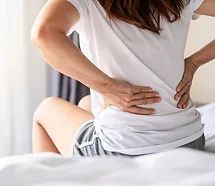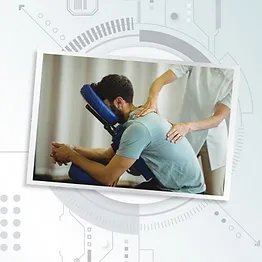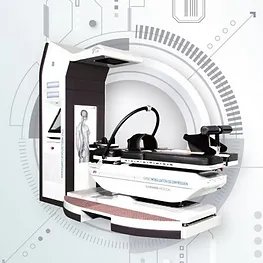Back Pain
Pain Symptoms
Headache Symptoms
Shoulder & Neck Pain
Spine & Joints
- Disc-herniation
- Scoliosis
- Sciatica
- Back Pain
- Ankylosing Spondylitis
- Osteoporosis
- Pregnancy Pain
- Bone Spur
Upper Limbs
Lower Limbs

Stiffness in back
Spine consists of vertebras. If the vertebras are displaced and the spinal nerve roots are irritated, pain and lower limb numbness would be reported, and more severe symptoms like sciatica, incontinence and lower limb muscles atrophy would be encountered.
The causes of back pain can be acute and chronic
Acute back pain:It is usually caused by injuries in accidents or poor postures. Factors such as obesity, stress, osteoporosis, etc. may also lead to acute back pain. Some sudden movements may overstretch and exert pressure on the muscles; they cannot react promptly to contract themselves properly to protect the spine, leading to overstretched or torn muscles and ligaments.
Chronic back pain:It is usually caused by cumulative damage, ageing, prolonged poor posture or frequent heavy lifting that led to the gradual degeneration of lumbar vertebrae. Poor postures often cause spinal subluxation which exerts pressure on the nerves. This leads to back pain, limited limb movements, and even soreness and weakness in the lower back after prolonged walking or standing. Medical conditions such as disc herniation, sciatica, and ankylosing spondylitis can sometimes cause back pain. Under rare circumstances, back pain may be a symptom of severe problems such as bone fracture, cancer or infections.
Warning signs of back pain
Pain and repetitive strain injuries are extremely common if workstations are not set up ergonomically, forcing workers to work with unnatural posture for an extended period of time. Long working hours with unnatural postures can lead to high muscle tension. If the situation deteriorates, workers will feel pain beginning from the shoulder into the neck. Headaches might also occur later, which can indicate cervical spine misalignments. If there is osteophyte (bone spur) growth and nerve roots are irritated or compressed, pain and numbness will emerge along the upper limbs. Dizziness, photophobia and muscle atrophy can develop in severe cases.
Lower back exercises can train your muscles
The first step to protecting our lumbar vertebrae in our daily lives is doing lower back exercises. The lower back muscles are part of the core muscles. The normal contraction and functioning of core muscles can maintain stability and provide support for the spine, and also divert pressure from the spine to reduce the stress on the intervertebral disc. In our daily lives, our core muscles are essential to maintain the spine’s stability when heavy lifting, bending over and doing housework such as mopping and vacuuming the floor. Therefore, people of all ages should train their muscle strength through lower back exercises to prevent lower back injuries.



Tips to keep back pain away
To prevent from low back pain, it is necessary to pay attention to daily postures.
- 1. Maintain a good sitting and standing position
- 2. Pay attention to the posture when carrying heavy objects
- 3. Regular exercise
Chiropractic treatment
To help Spine and Physiotherapist diagnose the source of back pain, be specific in describing the type of pain, when it started, related symptoms, and any history of chronic conditions. Your Spine and Physiotherapist may order X-rays or MRI scans to look for damaged bones or discs, or other injuries to the spine.
Spine and Physiotherapist use spinal manipulation to treat low back pain by applying pressure with their hands to bones and surrounding tissues. For some cases, short wave diathermy, heat treatment, lumbar traction, interferential therapy would be used for muscle relaxation and symptomatic relief. And also the Spine and Physiotherapy F & D 3D spinal traction machine can apply traction force, releases and twisting force on the spine, help fix the spinal displacement.
- 1. Begin with both knees and hands on a soft mat. Face downwards.
Raise your right arm and left leg to form a straight line with your body. Repeat 10 times. Repeat on the other side 10 times.
Effects: Balance your arms, lower back and shoulder muscles. - 2. Step in the middle of the resistance band and hold its handles.
Bend your knees and lower your body. Look down and stop when your knees are right above your toes. Stand up back and repeat 10 times.
Back pain FAQ
Who is at high risk of back pain?
The symptoms of back pain vary with the pain location of the spine and its underlying cause. Generally speaking, the following factors will increase the incidence rate of back pain: smoking, obesity, lack of exercise, prolonged sitting or lying, prolonged vibration exerted on the back, poor posture at work, sedentary lifestyle or bending for long periods.
How to prevent back pain?
The key to preventing back pain is maintaining proper spine alignment. A misaligned spine will limit the space needed for each component of the spine. In other words, every component of the spine has its corresponding location. If it is damaged, the incorrect alignment can cause swelling and pain in the area of subluxation and obstruct nerve flow. These will disrupt the necessary pain sensations and nerve signals for daily function.
When should I see a doctor for back pain?
The spine is an important component of our body. If you experience persistent back pain symptoms, be careful and seek medical attention. Otherwise, you may suffer from chronic discomfort or even incontinence.



